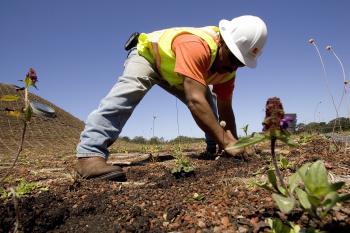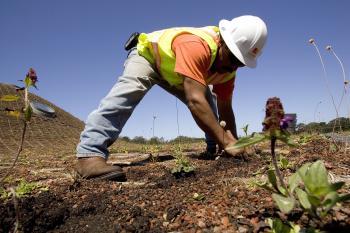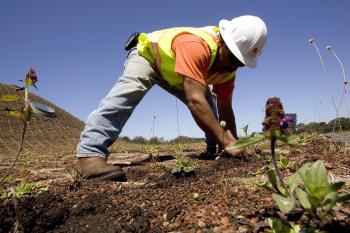All of these organizations are changing the way cities move into the future and how buildings need to function. Experts are encouraging industry players to get educated fast and stay up with the play.
“It’s not the big that eats the small, it’s the fast that beats the slow,” said energy reductionist Chris De Weaver at a Greenpearl forum recently. De Weaver advocated a team approach and at least knowing people who are experts.
The most significant legislation to impact New York City inhabitants and real estate owners is the new Greener, Greater Buildings Plan announced by Mayor Michael Bloomberg late last month.
The plan, said Bloomberg, “will dramatically improve New York’s energy efficiency and reduce energy costs by some three-quarters of a billion dollars a year.”
That’s a shaving off the yearly $15 billion in energy costs that the city’s one million buildings account for—or 80 percent of the city’s carbon emissions.
Greener, Greater Buildings Plan
There are four major facets of the Greater, Greener Buildings plan, should the legislation be passed in its current form.
Buildings of 50,000 sq. ft. or more will have to undergo an energy audit every 10 years and make any improvements that pay for themselves within five years.
All buildings of 50,000 sq. ft. or more will be given an energy efficiency rating. The rating will take into account water and heating on an annual basis and is designed to help owners and potential buyers examine the health of the building, and prioritize work.
Thomas Paino sustainable design project director of New York City’s Department of Design and Construction (DDC) said these four bills are bound to become law in some manner.
Mayor Bloomberg has set a target of 30 percent reduction of greenhouse gas emissions by 2017.
Local Law 86 and LEED
The DDC spends $500 million of tax payers money annually on renovations, new buildings, and additions, said Paino. He urges building owners and industry experts to become familiar with Local Law 86, which states that any project using city funding greater than $2 million must follow LEED guidelines.
LEED is a U.S. Green Building Council (USGBC) certification system. It measures a building’s performance in terms of energy savings, water efficiency, CO2 emissions reduction, improved indoor environmental quality, and stewardship of resources and sensitivity to their impacts.
“The emphasis is on energy reduction, greenhouse gas emission reduction,” Paino said.
The initially higher cost to go green will ultimately save public money through reduced bills, he said, citing an example: A small performing arts facility in the Bronx recently needed a new tap-dancing floor. Cake sales were held to raise money, but it was discovered they fell under the LEED law, so the costs increased. Paino said the facility got a grant to cover consultant fees, their new heating/cooling equipment was partially paid for, and they obtained an ongoing decrease in bills by 20 percent.
Version 3 of LEED was released last week—apparently causing a crash on the USGBC’s web site as people flocked to register under the old guidelines before the change.
{xtypo_sticky}
Solar Incentive Facts
Tax abatement:
- For eligible solar electric generating systems*
- Class 1,2, and 4 buildings
- 4-year tax abatement
- If the solar electric generating system is placed in service before Jan. 1, 2011, the amount of the tax abatement would be 8.75 percent for four years
- If the solar electric generating system is placed in service after Jan. 1, 2011, and before Jan. 1, 2013, the amount of the tax abatement would be 5 percent for four years
- Benefit will not exceed $62,500 per year
- Tax abatement will be applied by the City’s Department of Finance.
Cash back installation program:
- $13.8 million in funding
- incentives granted on a first-come, first-served basis
- applications close Sept. 30, 2009, or until funds are fully committed
- in general, incentives for a typical residential or commercial system cover approximately 40-45 percent of the installed cost of a photovoltaic system
- administered by NYSERDA
*Eligible solar electric generating system expenditures include reasonable expenditures for materials, labor costs properly allocatable to on-site preparation, assembly and original installation, architectural and engineering services, and designs and plans directly related to the construction or installation of the solar electric generating system.
{/xtypo_sticky}
{xtypo_sticky}
Green Roof Incentives
A one-year tax abatement is available in the pilot Green Roof program on class one, two, or four buildings in New York City.
The abatement is equal to $4.50 per square foot of green roof, up to $100,000. In general, a green roof is an addition to a roof that includes, among other things, a growth medium and a vegetation layer of drought resistant and hardy plant species.
Reasons for adding a green roof to buildings are multiple, not least of which is to lessen the problem of sewage run-off.
One tenth of an inch of rain is enough to cause raw sewage run-off into New York City’s rivers, creeks, canals, and other bodies of water—resulting in two billion gallons of run-off a year. That’s equivalent to more than 3,300 Olympic-sized swimming pools of raw sewage a year.
Green roofs reduce the volume of runoff by absorbing or storing water. According to a recent study by Riverkeeper, a 40-square-foot green roof could result in the capture of 810 gallons of storm water per year. This approach to stormwater capture on a large scale has the potential to significantly reduce the strain on the municipal sewer infrastructure during rainy seasons.
Green roofs offer additional benefits such as improved air quality, insulation for both improved energy efficiency and noise reduction, and mitigation of the urban heat island effect. Green roofs also provide natural habitats and wildlife corridors for migrating species, and act as a carbon sink.
New York City real property falls into four classes: class one, one-, two- and three-family homes; class two, most apartment buildings; class three, utility real property; and class four, all other real property.
The pilot program amends Article 4 of the Real Property Tax Law and ends on March 15, 2013.
SOURCE: New York State Senate Bill
{/xtypo_sticky}








Friends Read Free